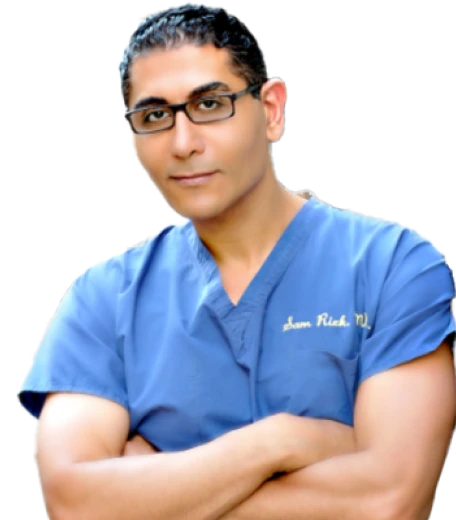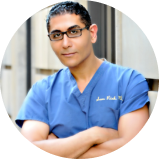When it comes to cosmetic enhancement, celebrities are really no different from the rest of the population. Both minimally invasive treatments such as injectable fillers and more involved surgeries like facelift are popular among celebrities. Like anyone else, their choice of treatment depends on their desires and needs.
At my practice I treat a spectrum of people, from celebrities to the average Joe. Most patients wanting to address signs of facial aging have similar questions about facelift and injectable fillers. Below are answers to a few of the most common questions these patients ask me.

What Is the Difference Between Facelift and Injectable Fillers?
Injectable Fillers
Injectable fillers are minimally invasive treatments; they require simple but strategic injection of a filler into areas of the face that are showing signs of aging. Injectable fillers can be used to address a variety of signs of aging in the face, including loss of volume, sun damage, and the appearance of wrinkles, folds and creases.
Fillers such as Restylane fill in wrinkles and creases, whereas neurotoxins like Botox® are used to paralyze the muscles that cause wrinkles to form. Lasers are used to address skin spots and other signs of moderate sun damage. The effects of injectable fillers last a few months up to a couple of years, depending on the treatment. As a result, most of these procedures require multiple treatments and ongoing maintenance, spaced out over months or years. “This can be troublesome for many patients,” says Dr. H. Bagga.
Facelift
In contrast, the results of a facelift can last a decade or longer. This invasive surgical procedure is used to address more severe drooping. The type of facelift procedure performed depends on the unique needs of the patient.
Patients in their early 40s may benefit from a relatively simple, less-invasive procedure to target less-advanced aging in the face and neck. This procedure is called partial rapid-recovery facelift.
A mid-facelift is intended to improve the appearance of lines extending from the nose to the mouth. It can also be used for sagging cheeks. This type of facelift is generally intended for patients in their 40s or 50s, as they begin to develop skin folds and nasolabial laxity. A mid-facelift requires less downtime but the results are not as dramatic as those achieved with full facelifts.
A full facelift is a far more involved procedure. I generally perform this procedure on slightly older patients who are experiencing major volume loss in the mid-face and/or developing deep lines, jowls and loose skin and muscles in the neck. A full facelift is effective at counteracting the effects of gravity and aging.
When Do You Recommend a Facelift and When Do You Recommend Fillers?
Non-surgical facial rejuvenation procedures, including injectable fillers, have their place, but their results are temporary. Injectable fillers are good for addressing moderate signs of aging. They can last a few months up to a couple of years, depending on the patient and the type of treatment.
A facelift is appropriate when non-surgical methods no longer suffice. This can happen in a patient’s 40s, 50s or 60s, as the effects of gravity, sun damage and genetics take hold. At this point the skin begins to sag, and cannot be treated effectively with injectable fillers or other minimally invasive treatments. I often perform facelift on patients who complain that they are developing a “worn” look; that is, those who are experiencing the following: lines around the corners of the mouth; jowls; significant loss of skin elasticity; deep wrinkles beneath the lower eyelids; deep creases from the nose to the corners of the mouth; and loose neck skin. To be considered a good candidate for facelift, it is important that a patient be in good physical and mental health and have realistic expectations. For younger patients, a less-invasive procedure may be more appropriate.
In many cases, fillers and facelifts can be used in combination, since fillers address one type of aging (volume loss under the eyes and cheeks) while facelift addresses another (e.g., gravitational jowls and/or a loose neck). Fillers do not work on the neck although Botox can be used in neck for early signs of active tense cords (note, however, that it does not work on loose cords).
How Can I Look Young if I’m Not a Celebrity?
People often ask me how celebrities manage to look so young, even into their 40s and 50s and beyond. While it’s certainly true that many celebrities turn to cosmetic surgery, another important factor in their youthful look is the fact that they understand how to take care of their skin. You can go a long way to maintaining a youthful look by avoiding smoking and the sun. Practice good skin-care habits such as exfoliating to get rid of dead layers of skin, which makes the skin appear smoother. Also moisturize your skin when necessary to avoid leathery or cracked-looking skin. Using high-quality skin products is another important factor; ask me or a board certified dermatologist for tips on the best brands and products.
But no matter what steps we take to stave off the inevitable, at some point we will all begin to show signs of aging. When the skin begins to sag and lines appear, many celebrities and common folks alike seek out facial plastic surgeons.
The key at this point is to pick the right facial plastic surgeon. In fact, you may even be able to achieve better results than some celebrities, simply by doing better research and finding a skilled surgeon. It is very important that you select a board certified facial plastic surgeon to perform your procedure, whether it’s the injection of fillers or a full facelift. Make sure to read through patient testimonials and look at a surgeon’s before and after pictures.
If you choose me to perform your facial rejuvenation, you can expect to be treated as if you were a celebrity.














